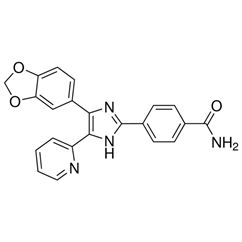Recombinant Mouse EGF (Animal-Free)
Induced proliferation of BALB/c 3T3 cells assay for Mouse EGF. Cell proliferation was measured to calculate the ED50, which is as expected less than 250 pg/ml.

Non-reducing (-) and reducing (+) conditions in a 4 - 20% Tris-Glycine gel stained with Coomassie Blue. 1 μg of protein was loaded in each lane. Mouse EGF has a predicted Mw of 6 kDa.
Achieve Purchasing Synergy
Request a quote at [email protected] for 2 or more vials of any Growth Factor to receive a discount. Discounts range from 5 to 20% according to the size of your order.
PODS® Growth Factors
The product is currently not available as PODS®, please check back in the future.Animal-Free
This product is produced with no animal derived raw products. All processing and handling employs animal free equipment and animal free protocols.Description
Epidermal Growth Factor (EGF) is a growth factor that stimulates the proliferation, differentiation, and survival of epithelial and epidermal cells. EGF contains three intramolecular disulfide bonds and binds in high affinity to the epidermal growth factor receptor (EGFR). EGF is overexpressed in multiple tumor cell lines and promotes resistance to chemotherapy and radiation treatments.Activity Assay
Mouse EGF (Animal-Free) is fully biologically active when compared to standard. The activity is determined by the dose-dependent proliferation of BALB/c 3T3 cells proliferation and it is typically less than 250 pg/ml. This corresponds to an expected specific activity of 4 x 106 units/mg.AA Sequence
MNSYPGCPSS YDGYCLNGGV CMHIESLDSY TCNCVIGYSG DRCQTRDLRW WELRAlternative Names
Epidermal Growth Factor, pro-epidermal growth factor, urogastrone, URG, β-urogastrone, HOMG4| Product Details | |
|---|---|
| Length | 54 aa |
| Molecular Weight | 6.2 kDa |
| Structure | Monomer |
| Source | E. coli |
| Accession Number | P01132 |
| Purity | ≥95% determined by reducing and non-reducing SDS-PAGE |
| Endotoxin Level | ≤1.00 EU/μg as measured by kinetic LAL |
| Formulation | Lyophilized from a sterile (0.2 micron) filtered aqueous solution containing 10 mM sodium phosphate, pH 7.5 |
| Reconstitution | Centrifuge vial before opening. When reconstituting the product, gently pipet and wash down the sides of the vial to ensure full recovery of the protein into solution. It is recommended to reconstitute the lyophilized product with sterile water at 0.1 mg/ml, which can be further diluted into other aqueous solutions. |
| Stability and Storage |
12 months from date of receipt when stored at -20°C to -80°C as supplied. 1 month when stored at 4°C after reconstituting as directed. 3 months when stored at -20°C to -80°C after reconstituting as directed. |






